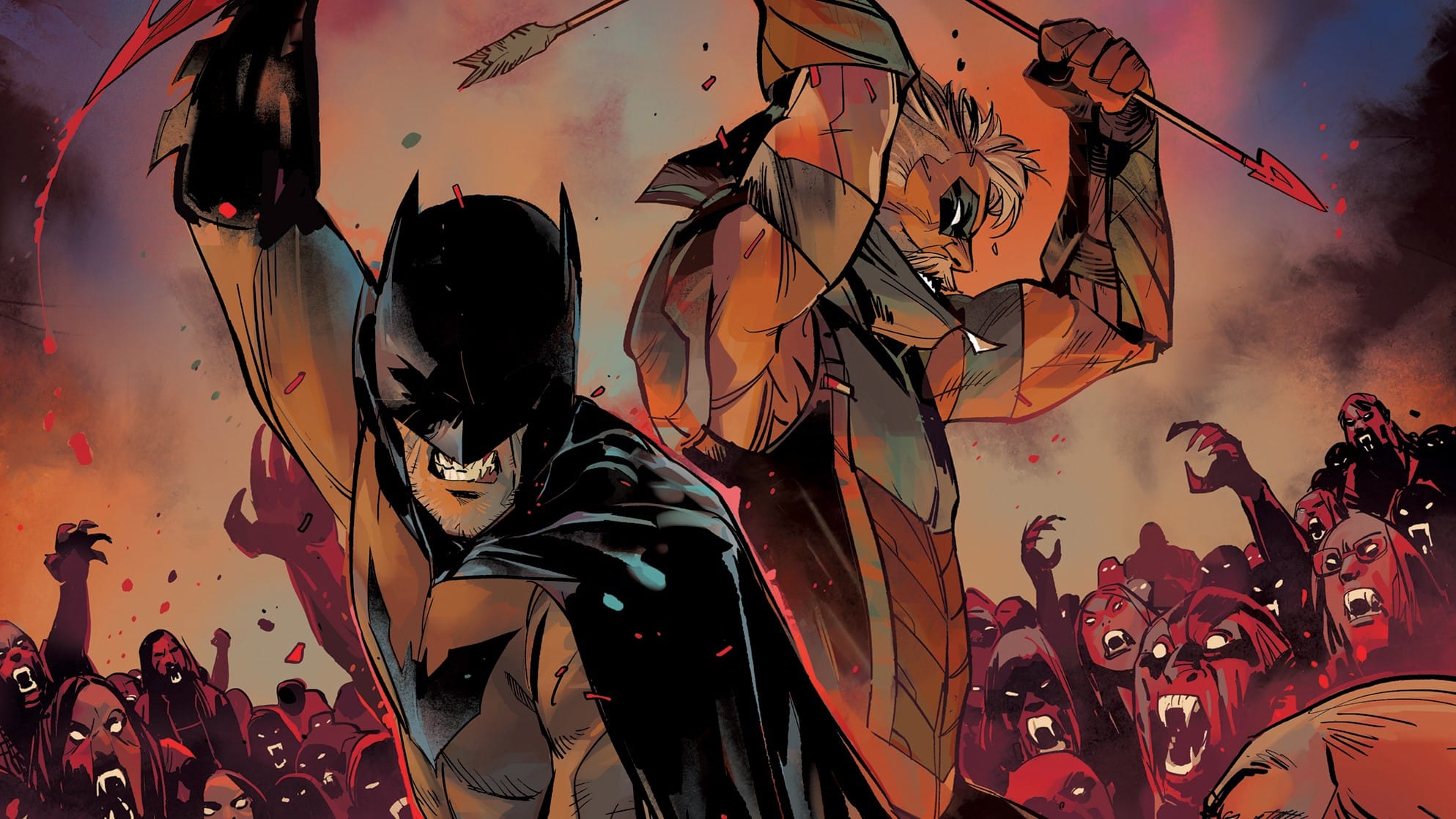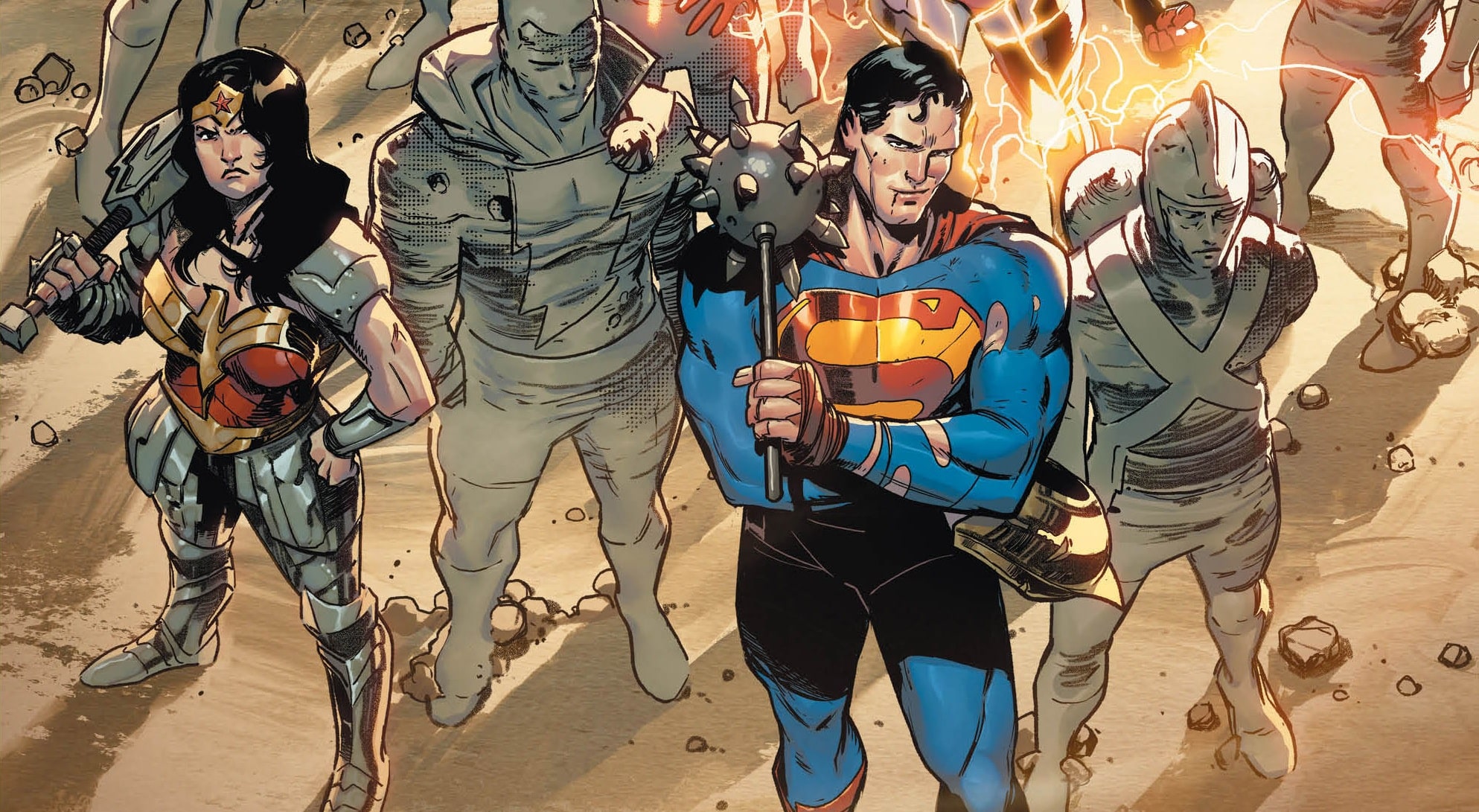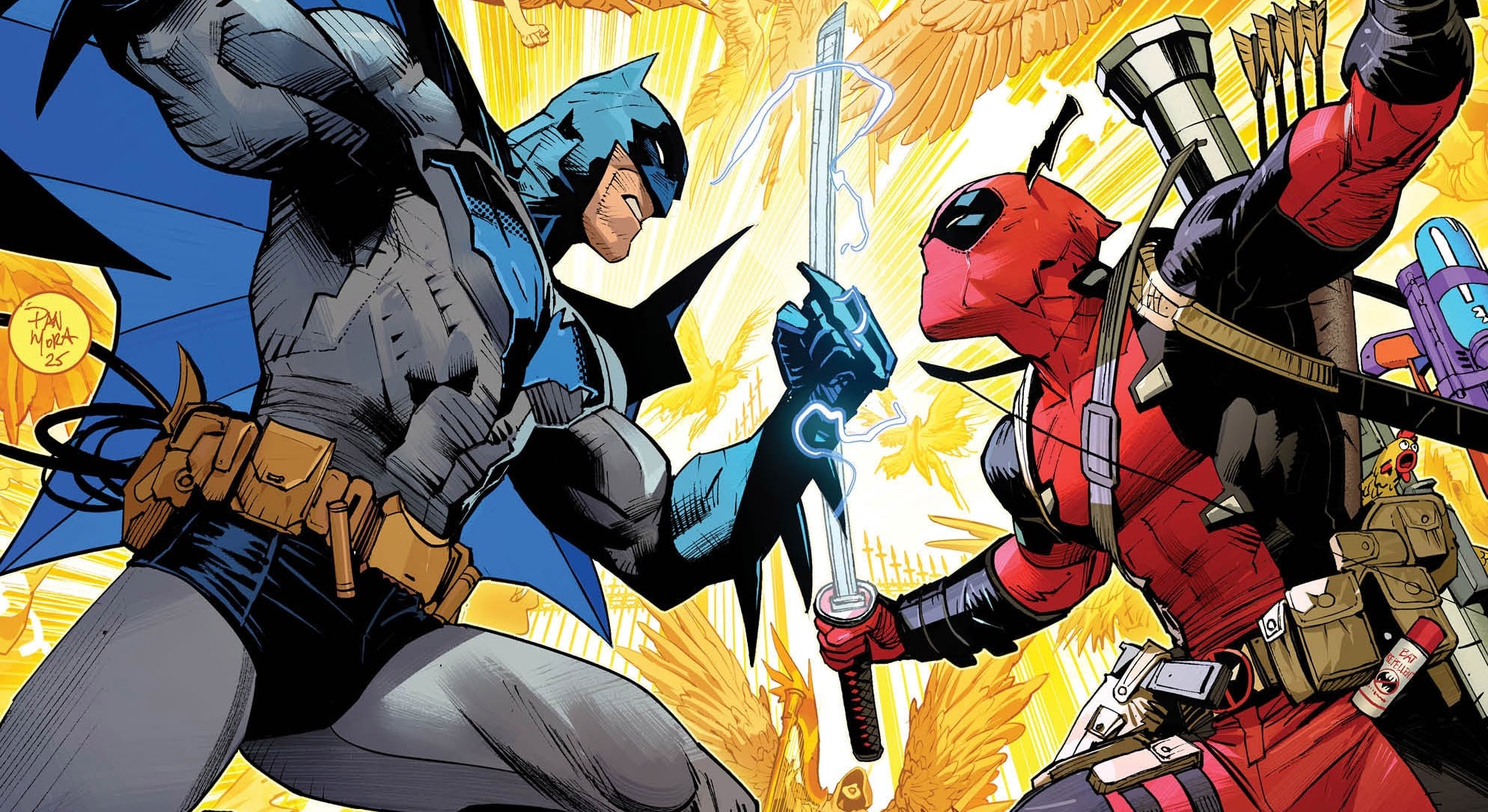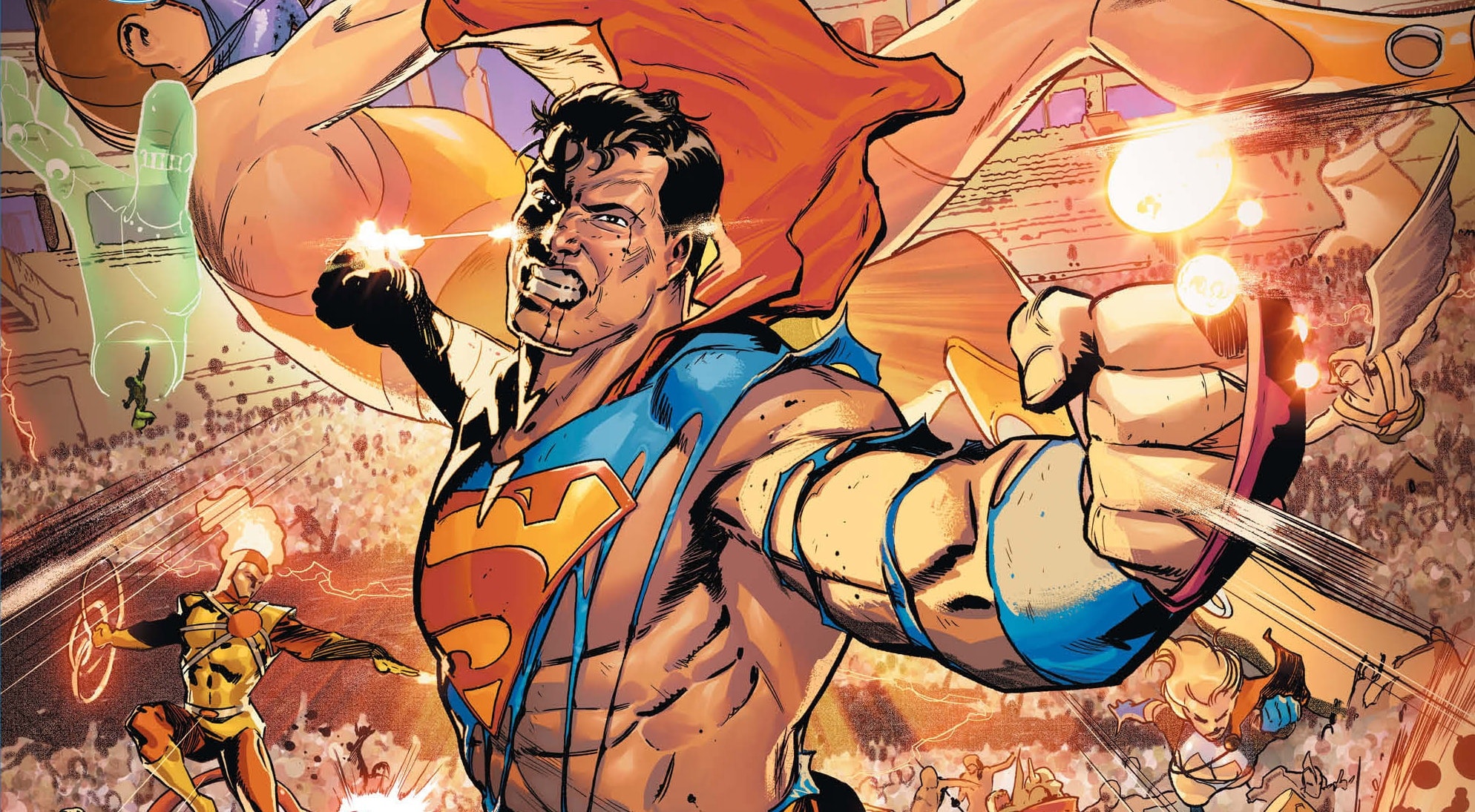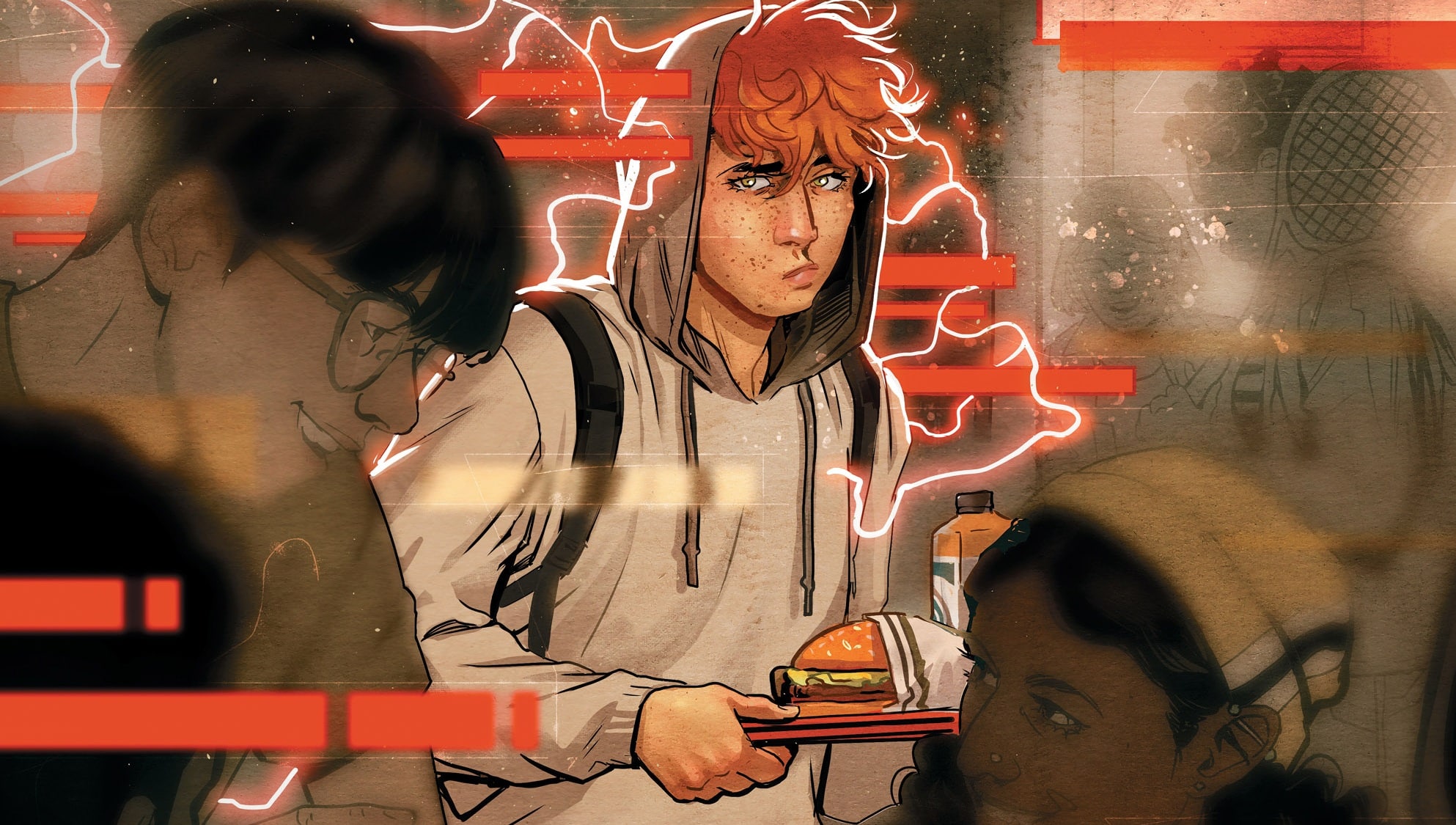Ari: Alrighty, let’s take a stroll through yet another DC alternate universe where a lot of heroes die, this time featuring vampires and the creative team of Matthew Rosenberg, James Tynion IV, Otto Schmidt and Tom Napolitano in DC vs. Vampires #1.
Ritesh: I’m glad you mentioned this, because this is certainly part of that trend. That said, I also think this stands out in ways that intrigue me.
Ari: Oh yeah? How is that?
The Aesthetic

Ritesh: Well, for starters, for once this sort of thing has an actually distinct artistic aesthetic! My god! Otto Schmidt, god bless him! He’s here to save us!
Ari: This is true, and you can tell right away primarily because of Schmidt’s use of backgrounds. He invokes a style where he only displays what’s important, such as establishing locations every third or fourth panel. It’s an efficient style of storytelling and draws our attention to a narrator who might be unfamiliar to some, Andrew Bennett.
Ritesh: Yeah, absolutely. But to add to that, just in general, I quite like how much Schmidt’s cartoony style leans away from the “realistic” end of the spectrum that many such endeavors tend to go for, and leans into the wonderfully exaggerated. It makes it that much easier to get into and sets such a clear, evocative tone that just pulls you right in and places you in the world of its story.
Ari: Exactly. It’s definitely cartoony, but also straight-laced in a sense. The lines are extremely sharp, thin and crisp. It gives off the feeling that everything is supposed to be tucked in and neat, but also that there might be something lurking beneath the surface. Then, when everything goes red, Schmidt is really able to let loose and sound the proverbial alarm. Oh no, it’s already too late. You know how the story plays out from here, now it’s just a matter of watching the violence unfold and chaos reign.
Ritesh: His characters are so sharp. Schmidt’s art looks like the man was born to draw Count Olaf. Lanky characters, sharp noses, a sense of the gothic, a pinch of horror and the macabre, and voila! But also he does draw the gruesome and the brutal quite nicely, which is all to say, Horror as Aesthetic looks bloody great here rather than just feeling generic, like it’s a stock and standard superhero book with horror bits splashed onto it. This is a proper horror title first and foremost, and that mood is never lost, and eternally clear.
Ari: Agreed. After the palette becomes draped in red, the tone and aesthetic becomes more akin to a post-apocalyptic zombie outbreak than your standard Big Two comic. Schmidt is willing to let go of conventional superhero trappings and bring in other genre elements, and it really elevates DC vs. Vampires above similar comics we’ve seen at DC and Marvel. I felt a little bit of suspense and terror for once instead of just opening a comic like this and expecting to count the number of dead heroes per issue.
Ritesh: Right?? It’s visually interesting while having a thriller element, and it commits to its genre hook and gimmick. I have no complaints. I am pleased.
The Prevalent Premise
Ari: I suppose before we can evaluate the comic on how well it accomplishes what it sets out to do, we must first speculate on the purpose of these post-apocalyptic, alternate universe, “destroy all heroes” types of comics. Is there anything beyond the simple injection of horror and hyperviolence into their favorite superheroes, or is that all that’s needed to bring in the dollars?
Ritesh: The Superhero vs. The Apocalypse, The Hero vs. The End has always been the fundamental doom and terror that all superhero comics gesture at and head toward. It’s the thing that is always prevented, the calamity that is always avoided, the crisis ever averted, for the world must go on. These comics merely just ditch the idea that things can’t change and dive into the “What If?” of it all. What if the world was truly doomed and screwed? What if the superheroes finally failed?
It’s every Bad Alternate Future we see, it’s the same fundamental principle. It’s that same core appeal and draw, except instead of cutting far ahead to the end, you get to actually watch it all happen and go down live. So there is, in a sense, a certain mass appeal to that. It makes sense.
Ari: I suppose you’re right. The appeal really is in the descent, the trip down below from which there is no return. Perhaps there is some ambiguity surrounding how much will be left by the end, but I think most know that all that lies ahead is ruin. The best of these comics make that clear very early on. Perhaps it was the Hall of Doom decimated and riddled with bodies, or maybe it was the very graphic blender scene, but it wouldn’t be an effective issue #1 unless hope was quashed and the crisis was definitely not averted.
Also, I love that this comic seems to deliberately invoke sensibilities of the old Super Friends cartoon. The way it often transitions from Bennett’s backstory to the present through establishing shots of the Hall of Doom and the Hall of Justice brings back the striking memory of Ted Knight’s voice going “Meanwhile, at the Legion of Doom” in an ominous voice.
Ritesh: Yes! It even has Zan from the Wonder Twins! It plays like a classic Justice League story, for all intents and purposes, and frames itself as such. Schmidt’s cartoony, angular style fits GREAT for that, too, to be evocative of that unreality and world of funny figures. Which is also when the pages of bloody horrific murder and reds/blacks hit with the commitment to the horror aesthetics? It rules. It has impact. This comic knows what it’s doing. It opens like any potential spec script for Super Friends could, and then twists on that.
It reads like a story that could, when completed, be handed to someone who’s never read a DC or Justice League comic before, but knows the characters via cultural osmosis. They’d get it. You could probably hand it to an old person [Grote’s note: Guys, I’m RIGHT here] who’s only seen Super Friends and they might get a kick out of it if they’re a horror person, too. I’m into that. I like what’s being done here.
Ari: Exactly. It’s also worth pointing out that Andrew Bennett, while definitely the most sensible pick as one of the only vampires in the DCU, is also a rather deep cut for a book like this and someone most may be unfamiliar with. Nevertheless, I don’t think that matters. Tom Napolitano’s lettering has the gravitas it needs in the beginning, and we are instantly shown that this character matters. Let’s be honest, Andrew Bennett is the bait on the hook, and it’s effective.
Ritesh: I, Vampire baby!! He’s back! I know many missed him, so happy for all those folks. You finally get your boy in something! But yeah, agreed. It’s a nice, fun inclusion if you know and dig it, but if not, it’s fine.
Vampire Hal Jordan

Ritesh: I gotta say, I loved this bit. I wasn’t expecting it, and it totally got me. It won me over.
Ari: Yeah, it’s a great bit. Especially because the immediate reaction after the initial shock is just, “Of course, Hal Jordan, you dumbass.” If anyone had to go and get themselves turned into a vampire, it’s Hal Jordan, and I must say, these new abilities and everything that comes with the transformation must also affect one’s intellect and creativity, because I have never seen a construct as creative as a noose hanging above a swirling blender of sawblades come out of Hal’s power ring. Honestly, that graphic construct is really what got me.
Ritesh: Ahaha, funnily enough, Classical Hal used to always be like that. He just tends to be dumbed down is all. John Broome/Gil Kane Hal always came up with the most weirdly creative constructs.
What I love about all this though is this: You’ve now got The Hero of Light as The Vampire, the brightly colored stellar champion, the literal least suspicious and least likely figure you’d expect to be The Vampire … facing The Dark Knight in Batman, the guy who would be #1 on the list of OK Who’s Turned Into A Vampire? That dude is vampiric looking as all hell, draped in gothic imagery. So for this fun reversal to be the case? I’m into it. But also, Hal and Bruce are characters who’ve long had a lot of cool chemistry, which is usually wasted or not capitalized on. Geoff Johns used it poorly, by and large, but in the right hands, it could be a ton of fun.
So Hal Jordan the Vampire, the Bright Wolf Amidst the Sheep of the superhero community, with Batman hunting him and trying to crack this vampire problem? That’s a really interesting dynamic and setup to kick off with.
Ari: I like that you’re thinking from a thematic perspective, and you’re definitely right, but I’m thinking from an intelligence perspective based on my familiarity with these characters, and one of my first thoughts was, “Yeah, this makes sense.” Zan’s the lovable idiot who really makes the scene, however, and the “Oh, I wish you hadn’t said that” along with the SFX made for a great reveal sequence. Poor guy, though, no way to activate his Wonder Twin powers without Jayna, and Andrew Bennett met his untimely end as well, but not before taking some extra precautions. I suppose the game is afoot!
Ritesh: Hah, yeah. And in a sense, it fits with Hal for me? Like, in the Grant Morrison/Liam Sharp era of The Green Lantern, his big Love-Interest/Deadly-Antagonist (Hal has a type) and Wife/Ex-Wife was Space Vampire and Countess Belzebeth. She was attracted to Hal and described him as the most dangerous and deadly man in all the universes. Hal’s the kind of guy who attracts vampire queens, so him as vampire? Yeah, I can have fun with that. That should be a blast! Straight up cartoonishly evil Hal should be quite enjoyable here given how much this book is leaning into and committing to its bits.
Ari: Definitely, and now Batman has to race against the clock before Hal and the vampires block out the sun and eliminate one of their biggest weaknesses!

